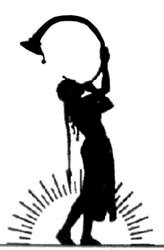
Shantaram Rajaram Vankudre, referred to as V. Shantaram or Shantaram Bapu, was an Indian film director, film producer, screenwriter and actor known for his work in Hindi and Marathi films. He is most known for films such as Dr. Kotnis Ki Amar Kahani (1946), Amar Bhoopali (1951), Jhanak Jhanak Payal Baaje (1955), Do Aankhen Barah Haath (1957), Navrang (1959), Duniya Na Mane (1937), Pinjara (1972), Chani, Iye Marathiche Nagari and Zunj.
Parallel cinema or New Indian Cinema, is a film movement in Indian cinema that originated in the state of West Bengal in the 1950s as an alternative to the mainstream commercial Indian cinema.

The 10th Lok Sabha, elected during 1991 Indian general election held during May–June 1991. The Lok Sabha is the lower house in the Parliament of India, four sitting members from Rajya Sabha, the Upper House of Indian Parliament, were elected to 10th Lok Sabha after the Indian general election, 1991.

Prabhat Film Company was an Indian film production company and film studios founded in 1929 by the noted film director V.Shantaram and his friends.

Narayan Hari Apte, popularly known as Nanasaheb Apte was a Marathi popular novelist, writer of advice books and editor from Maharashtra, India.

Baburao Krishnarao Mestry, popularly known as Baburao Painter was an Indian filmmaker and artist. He was a man of many talents with proficiency in painting, sculpture, film production, photography, and mechanical engineering.
Netaji Palkar is a 1927 Indian biopic historical silent film directed by V. Shantaram. Kaishavrao Dhaiber who was an apprentice with Damle, co-directed the film. He was to become the chief cinematographer for Shantaram in his later films. Made under the Maharashtra Film Company, Kolhapur, it was the first film directed by Shantaram. The director of photography was S. Fattelal and the cast included Ansuya, Balasaheb Yadav, Ganpat Bakre and Zunzarrao Pawar.

Gopal Krishna is an Indian religious silent film made in 1929. It was directed by V. Shantaram for his newly formed Prabhat Film Company. The film was a "solo debut" for Shantaram, after co-directing Netaji Palkar (1927) with K. Dhaiber for the Maharashtra Film Company. The story was written by Shivram Vashikar and the cast composed of Suresh, Kamaladevi, Anant Apte, Sakribai and G.R. Mane.

Udaykal is a 1930 historical silent film co-directed by V. Shantaram and Keshavrao Dhaiber. It was produced by Prabhat Film Company. The story was written by Baburao Pendharkar. The cinematographers were S. Fattelal and V. G. Damle. The film starred V. Shantaram, Baburao Pendharkar, Kamla Devi, G. R. Mane, Ibrahim and Dhaiber.

Sinhagad is a 1933 Marathi historical fact film directed by V. Shantaram. The production company was Prabhat Film Company. The story was based on Hari Narayan Apte's literary classic novel "Gad Ala Pan Sinha Gela". Apte was a famous Marathi novelist of the early twentieth century. The story's screenplay and dialogue were written by Narayan Hari Apte. The cinematographers were V. Avadhoot and Keshavrao Dhaiber. The cast included Master Vinayak, Baburao Pendharkar, Keshavrao Dhaiber, Leela Chandragiri, Shinde, Prabhavati, Budasaheb and Shankarrao Bhosle.
Khooni Khanjar is a 1930 Indian silent film directed by V. Shantaram. The film was a costume action drama film co-directed by Keshavrao Dhaiber. It was produced by Prabhat Film Company. The cinematography was by Sheikh Fattelal and Vishnupant Govind Damle. The cast included Mane Pahelwan, Ganpat G. Shinde, P. Jairaj, Sakribai and Shankarrao Bhosle.

Agnikankan: Branded Oath also called The Branded Oath, is a 1932 Marathi adventure film directed by V. Shantaram. The film was a Prabhat Film Company production and was a bilingual, called Jalti Nishani in Hindi. The cinematography was done by Keshavrao Dhaiber and Art direction by S. Fatehlal. The sound direction was by Vishnupant Govind Damle and the music and lyrics were by Govindrao Tembe. Dialogues for the movie are written by Govindrao Tembe. The character artist Gajanan Jagirdar began his career in films by acting the role of a seventy-five-year-old man at the age of twenty-five. The cast included Shankarrao Bhosle, Kamala Devi, Master Vinayak, Baburao Pendharkar, Nimbalkar and Jagirdar.

Sairandhari (सैरंध्री) a 1933 Indian film based on an episode from the Mahabharata and directed by V. Shantaram. The film was a bilingual made as Sairandhari in both Marathi and Hindi. Produced by Prabhat Film Company, it has been cited as one of the 21 "most wanted missing Indian treasures" by P K. Nair, the National Film Archive of India founder. The music composer was Govindrao Tembe. The cast included Master Vinayak, Leela, Prabhavati, Shakuntala, G.R. Mane, Nimbalkar and Shankarrao Bhosle.

The Immortals is an Indian documentary directed by Shivendra Singh Dungarpur.
Sairandhari is a 1920 Indian film based on an episode from the Mahabharata and directed by Baburao Painter and Produced by Maharashtra Film Company. V. Shantaram remade it as Sairandhri in 1933.











